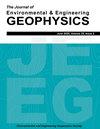基于核最小噪声分数的机载瞬变电磁非线性降噪方法
IF 0.7
4区 工程技术
Q4 ENGINEERING, GEOLOGICAL
引用次数: 1
摘要
机载瞬变电磁法已成为勘探深部资源和构造的有力工具。然而,与地面瞬变电磁法相比,飞机振动和飞行环境会产生非常强烈和复杂的非线性噪声,导致数据质量差。因此,降低机载电磁噪声对数据反演成像至关重要。为了抑制和去除非线性噪声,我们提出了核最小噪声分数(KMNF)方法,这是一种最小噪声分数的非线性广义方法。首先,采用自适应变窗宽滤波算法对噪声进行评估并进行初步去噪。然后,我们采用最小噪声分数(MNF)和最小噪声分数(KMNF)两种滤波方法来抑制噪声。结果表明,这两种方法都能有效抑制噪声,使衰减曲线平滑,但核MNF对噪声的非线性特性更有效,且不会减弱异常。最后,采用MNF和KMNF方法对秦岭矿区的实测数据进行了处理。结果表明,两种方法均能有效抑制非线性噪声,但KMNF方法的抑制效果优于线性MNF方法。本文章由计算机程序翻译,如有差异,请以英文原文为准。
Nonlinear Noise Reduction for the Airborne Transient Electromagnetic Method based on Kernel Minimum Noise Fraction
The airborne transient electromagnetic method has become a powerful tool to explore deep resource and tectonic structures. However, aircraft vibrations and flight environments produce very strong and complex nonlinear noise and result in poor data quality compared to ground transient electromagnetic methods. Consequently, the reduction of airborne electromagnetic noises is of vital importance to data inversion and imaging. To suppress and remove the nonlinear noise, we propose using kernel minimum noise fraction (KMNF), which is a nonlinear generalized method of minimum noise fraction. First, an adaptive variable window-width filtering algorithm is used to evaluate the noises and perform the preliminary denoising. Then, we adopt the two filter methods, which are minimum noise fraction (MNF) and KMNF to suppress the noise. The results show that these two methods can both suppress noise and make the decay curves smooth, but kernel MNF is more effective for the nonlinear characteristics of noise and it does not weaken the anomaly. Finally, field data from the Qinling mine area is processed, using the MNF and KMNF methods. The results show that nonlinear noise is suppressed by both methods but the results of KMNF are better than those of the linear MNF method.
求助全文
通过发布文献求助,成功后即可免费获取论文全文。
去求助
来源期刊

Journal of Environmental and Engineering Geophysics
地学-地球化学与地球物理
CiteScore
2.70
自引率
0.00%
发文量
13
审稿时长
6 months
期刊介绍:
The JEEG (ISSN 1083-1363) is the peer-reviewed journal of the Environmental and Engineering Geophysical Society (EEGS). JEEG welcomes manuscripts on new developments in near-surface geophysics applied to environmental, engineering, and mining issues, as well as novel near-surface geophysics case histories and descriptions of new hardware aimed at the near-surface geophysics community.
 求助内容:
求助内容: 应助结果提醒方式:
应助结果提醒方式:


